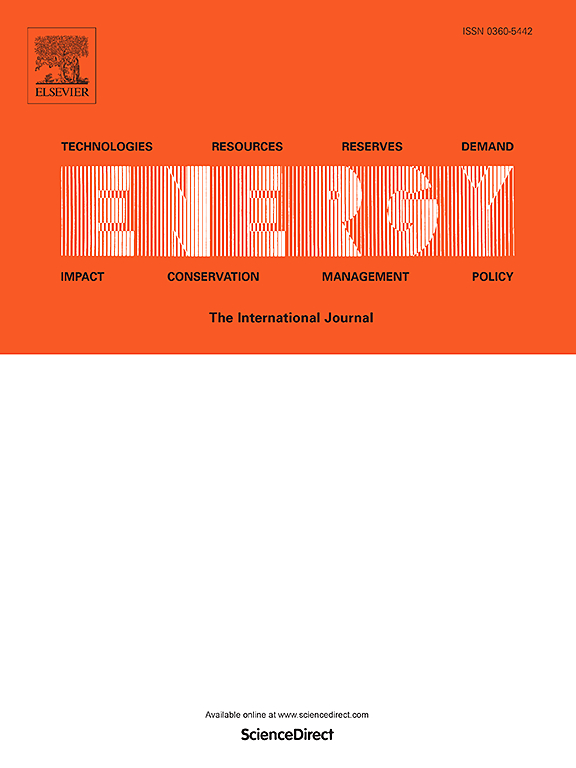基于自适应特征提取时频网络的显著波高预测新框架
IF 9
1区 工程技术
Q1 ENERGY & FUELS
引用次数: 0
摘要
有效波高(Hs)的准确预报对波浪能的开发利用至关重要。预测Hs的挑战来自于它的非线性和非平稳特性。分解预处理和机器学习模型的结合在提取数据特征的Hs预测中显示出显著的有效性。但是,分解测试集中的未知数据可能会导致数据泄漏问题。为了同时实现数据特征提取和防止数据泄漏,提出了一种新的自适应特征提取时频网络(AFE-TFNet),以提高预测精度和稳定性。它是一个编码器-解码器滚动框架。该编码器包括两个阶段:特征提取和特征融合。在特征提取阶段,结合小波变换(WT)和傅立叶变换(FT)提取全局和局部频域特征,并利用Inception块进行多尺度频率分析。在特征融合阶段,通过优势谐波序列能量加权(DHSEW)对时域和频域特征进行融合。解码器采用了一种先进的长短期记忆(LSTM)模型。以3个台站逐时实测风速(Ws)、优势波周期(DPD)、平均波周期(APD)和h为数据集,采用4个指标评价预报效果。结果表明,AFE-TFNet在预测精度方面明显优于基准方法。特征提取可以显著提高预测精度。DHSEW大大提高了中长期预报的准确性。AFE-TFNet的预测精度不随滚动时间窗大小的变化而变化。总的来说,AFE-TFNet在处理复杂信号预测方面显示出强大的潜力。本文章由计算机程序翻译,如有差异,请以英文原文为准。
A novel framework for significant wave height prediction based on Adaptive Feature Extraction Time-Frequency Network
Precise forecasting of significant wave height (Hs) is essential for the development and utilization of wave energy. The challenges in predicting Hs arise from its non-linear and non-stationary characteristics. The combination of decomposition preprocessing and machine learning models have demonstrated significant effectiveness in Hs prediction by extracting data features. However, decomposing the unknown data in the test set can lead to data leakage issues. To simultaneously achieve data feature extraction and prevent data leakage, a novel Adaptive Feature Extraction Time-Frequency Network (AFE-TFNet) is proposed to improve prediction accuracy and stability. It is encoder-decoder rolling framework. The encoder consists of two stages: feature extraction and feature fusion. In the feature extraction stage, global and local frequency domain features are extracted by combining Wavelet Transform (WT) and Fourier Transform (FT), and multi-scale frequency analysis is performed using Inception blocks. In the feature fusion stage, time-domain and frequency-domain features are integrated through dominant harmonic sequence energy weighting (DHSEW). The decoder employed an advanced long short-term memory (LSTM) model. Hourly measured wind speed (Ws), dominant wave period (DPD), average wave period (APD) and Hs from three stations are used as the dataset, and the four metrics are employed to evaluate the forecasting performance. Results show that AFE-TFNet significantly outperforms benchmark methods in terms of prediction accuracy. Feature extraction can significantly improve the prediction accuracy. DHSEW has substantially increased the accuracy of medium-term to long-term forecasting. The prediction accuracy of AFE-TFNet does not demonstrate significant variability with changes of rolling time window size. Overall, AFE-TFNet shows strong potential for handling complex signal forecasting.
求助全文
通过发布文献求助,成功后即可免费获取论文全文。
去求助
来源期刊

Energy
工程技术-能源与燃料
CiteScore
15.30
自引率
14.40%
发文量
0
审稿时长
14.2 weeks
期刊介绍:
Energy is a multidisciplinary, international journal that publishes research and analysis in the field of energy engineering. Our aim is to become a leading peer-reviewed platform and a trusted source of information for energy-related topics.
The journal covers a range of areas including mechanical engineering, thermal sciences, and energy analysis. We are particularly interested in research on energy modelling, prediction, integrated energy systems, planning, and management.
Additionally, we welcome papers on energy conservation, efficiency, biomass and bioenergy, renewable energy, electricity supply and demand, energy storage, buildings, and economic and policy issues. These topics should align with our broader multidisciplinary focus.
 求助内容:
求助内容: 应助结果提醒方式:
应助结果提醒方式:


